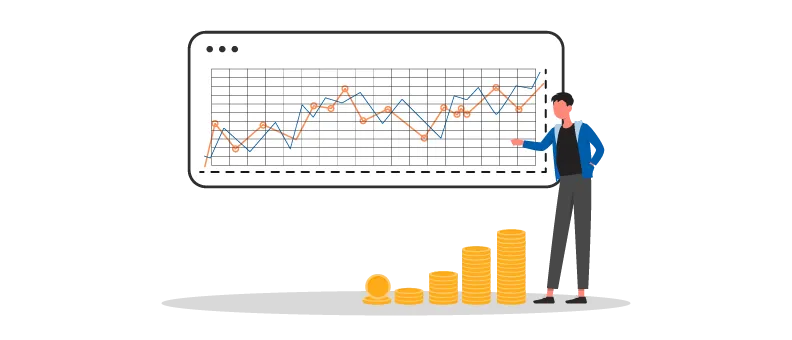Systematic Investment Plans (SIPs) have become an increasingly popular investment tool, offering a disciplined approach to wealth creation. SIPs in equity mutual funds and debt mutual funds each offer unique opportunities and risks, and understanding these can greatly shape an investor's portfolio.
Let’s analyse the risks and rewards associated with SIP in equity and debt funds.
- Understanding risk and reward in equity funds SIP
- Understanding risk and reward in debt funds SIP
- Comparing risk and reward of equity and debt funds SIP
- Tax implications of SIP in equity and debt funds
Understanding risk and reward in equity funds SIP
SIP investments in equity mutual funds India offer the potential for significant growth. Equity funds invest in a variety of stocks, aiming to benefit from market growth over time. The returns of equity fund SIPs can be substantial, thanks to the growth potential of the stock market, diversification across multiple stocks, and the flexibility to choose from various fund types.
By investing in a diverse range of stocks, these funds aim to capitalise on market growth, offering investors the chance to benefit from the economic success of various sectors and companies. Moreover, investors benefit from the expertise of professional fund managers with years of experience in handling portfolios. Additionally, the rewards in equity fund SIPs are not just limited to capital appreciation but also include potential dividend income, further enhancing the overall return on investment.
However, the risks are worth taking into consideration. The risks from SIPs in equity fund arise primarily from market volatility. Stock markets can fluctuate widely, and while in the long-term, the market may move upwards, short-term losses can be substantial. Furthermore, there’s liquidity risk, which refers to the lack of ease in converting investments into cash. Although generally liquid, certain market conditions can affect the liquidity of SIP investments.
SIPs in equity funds mitigate some of these risks through the benefits of compounding, rupee cost averaging, and disciplined investing. Compounding allows an investor's earnings to generate more earnings, while rupee cost averaging balances out the purchase cost over time, reducing the impact of market volatility. Discipline in regular investing, irrespective of market conditions, also plays a crucial role in managing risk.
Read Also: Estimate the future value of your SIP investments
Understanding risk and reward in debt funds SIP
Debt mutual funds typically invest in securities like government bonds, corporate bonds, and other fixed-income instruments. The primary reward in a debt fund SIP investment is the relative stability of capital. Compared to equity funds, debt funds usually offer more predictable returns and lower risk. They can be a suitable choice for conservative investors or those nearing retirement.
However, the risks associated with SIPs in debt fund cannot be ignored. Interest rate risk is a significant factor, as the value of fixed-income securities is inversely correlated with interest rate movements. Another risk is credit risk, where the issuer of the bond might default on payments. Moreover, debt funds are not entirely free from market volatility, although the impact is generally much less severe than in equity funds.
SIPs in debt funds offer the advantage of potentially steady accumulation of wealth and relatively lower volatility, making them a suitable option for investors seeking lower risk. Therefore, the main attraction of SIP in debt funds lies in their stability and predictability. These funds invest in fixed-income instruments like government and corporate bonds, offering more stable returns compared to equity funds. This makes them a suitable choice for conservative investors or those looking for a steady income stream. The predictable nature of returns, arising from interest payments, provides a cushion against the volatility of the stock market.
Comparing risk and reward of equity and debt funds SIP
When comparing SIP in equity vs. debt funds, the key difference lies in their risk-reward profile. Equity funds offer higher growth potential but come with increased volatility and risk. In contrast, debt funds can provide stability and predictable returns, but with lower growth potential. The choice between the two should be based on the investor's risk tolerance, investment horizon, and financial goals.
Tax implications of SIP in equity and debt funds
Here's a breakdown of the tax implications for SIPs in equity and debt funds:
Equity funds:
- Short-term capital gains (STCG): If you sell your equity fund units within one year of purchase, the profits are considered short-term capital gains. Tax rate: 20%
- Long-term capital gains (LTCG): Levied on capital gains on units held for a year or more. Tax rate: 12.5%. Gains of up to Rs 1.25 lakh in a financial year are tax-free.
Debt funds:
- All capital gains are taxed as per your applicable income tax slab, regardless of the holding period.
Conclusion
SIP investments in both equity and debt funds offer unique opportunities and challenges. Equity fund SIPs can be suitable for investors looking for growth, and who can tolerate short-term market fluctuations. On the other hand, debt fund SIPs can be a good option for those seeking stability and steady returns. A balanced approach, considering both types of funds, might be the optimal strategy for many investors.
Investors seeking to invest in different schemes can consider taking the help of an SIP calculator to plan their investments. The calculator estimates the potential size of your corpus considering your investment amount, horizon and expected returns. Based on these projections, investors can identify how to distribute their investments across debt and equity funds so that they can potentially achieve their financial goals. However, it's essential to note that the caculator's estimates are based on your inputs and real returns will depend on market conditions. You can also consider investing via a step up SIP, where your SIP contributions increase by a fixed percentage at regular intervals. This allows you to steadily increase your investments in line with growing incomes. A step up calculator can help you visualise the growth potential of this strategy.
FAQs:
What is the main risk associated with investing in equity funds?
The primary risk in equity funds is market volatility, where the value of stocks can fluctuate significantly in the short term. However, investing through SIPs can help mitigate some of the risks associated with equity funds.
What factors should I consider when analysing the risk of debt funds?
While SIPs in debt funds present a relatively stable and more predictable investment avenue, they are not without risks. It is important to understand the role of interest rate risk, credit risk, liquidity risk, and inflation risk.
How can I evaluate the historical performance of an equity fund?
To evaluate an equity fund's performance, look at its long-term returns, compare it with benchmark indices, and assess the fund manager's track record and investment strategy.
Which SIP is good, equity or debt?
The type of fund that is suitable for you depends upon your risk tolerance, investment horizon, and financial goals.
Equity SIPs offer higher long-term growth potential but are subject to market volatility and require a longer horizon (5+ years) to potentially ride out short-term growth potential.
Debt funds provide relative stability and lower risk but may not offer inflation-beating return potential in the long run. A lumpsum investment may be a more suitable strategy for debt fund investments as the entire capital gets market exposure from the start. However, investors who do not have a large sum to invest can consider debt SIPs if their investment horizon is short or if they do not have a very high risk appetite.
A balanced approach that combines both can also be considered.
A balanced approach that combines both can also be considered.
Yes, SIPs in equity funds are typically riskier than those in debt funds, but they also offer better long-term return potential. Equity funds experience greater volatility due to stock market fluctuations, making them suitable for long-term goals and investors with a high-risk tolerance.
Can I balance risk and reward potential by investing in both equity and debt funds?
Yes, you can. Equity funds offer higher returns but with increased volatility, making them suitable for long-term goals, while debt funds provide relative stability with lower risk and reasonable return potential, making them suitable for short-term objectives. A balanced approach with regular portfolio rebalancing can mitigate the impact of volatility on a portfolio, improve risk-adjusted returns and align investments with diverse financial goals.
What is the ideal investment horizon for SIPs in equity funds?
The suitable investment horizon for SIPs in equity funds is typically 5 years or more due to the benefits of compounding, rupee cost averaging, and the ability to potentially ride out market volatility. Longer time frames allow for better growth potential and mitigate the impact of short-term market fluctuations. Individual goals and risk tolerance should guide the investment horizon, with equity funds being more suitable for long-term objectives.
How can I track the performance of my SIP in equity and debt funds?
To track SIP investments, you can use AMC websites or apps for fund details, or investment platforms for consolidated views and personalized insights. Consolidated Account Statements (CAS) provide a comprehensive summary across AMCs, while portfolio tracking apps and spreadsheet software allow manual tracking and analysis. These tools collectively enable effective monitoring, informed decision-making, and streamlined management of your investments.
Related Searches:
Mutual Fund investments are subject to market risks, read all scheme related documents carefully.
This document should not be treated as endorsement of the views/opinions or as investment advice. This document should not be construed as a research report or a recommendation to buy or sell any security. This document is for information purpose only and should not be construed as a promise on minimum returns or safeguard of capital. This document alone is not sufficient and should not be used for the development or implementation of an investment strategy. The recipient should note and understand that the information provided above may not contain all the material aspects relevant for making an investment decision. Investors are advised to consult their own investment advisor before making any investment decision in light of their risk appetite, investment goals and horizon. This information is subject to change without any prior notice.


